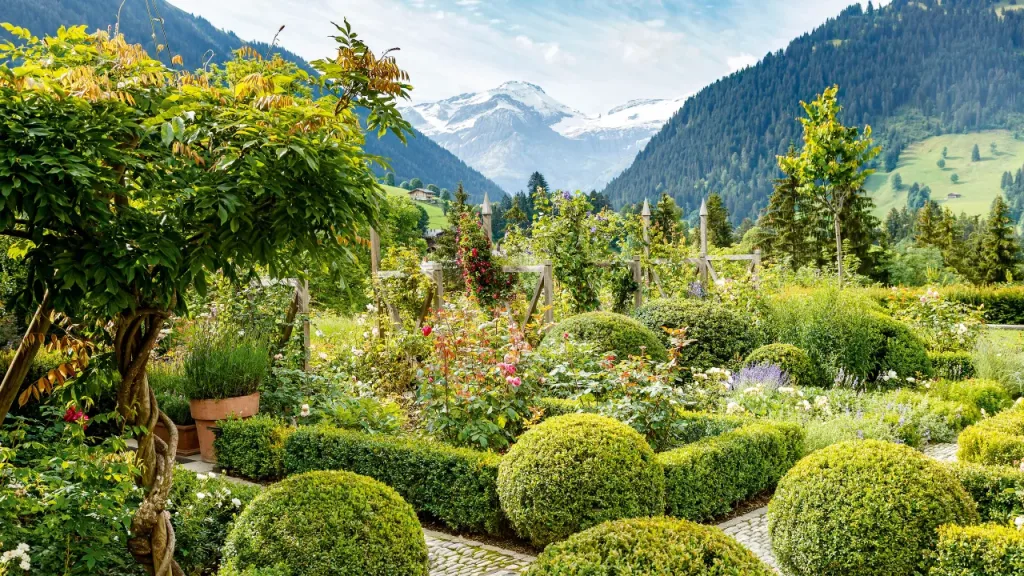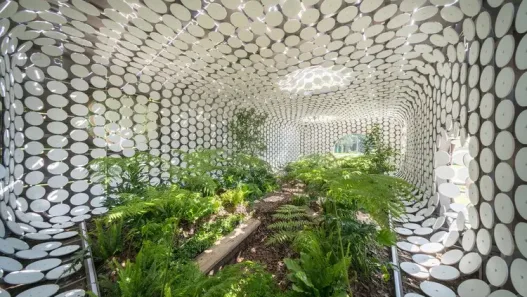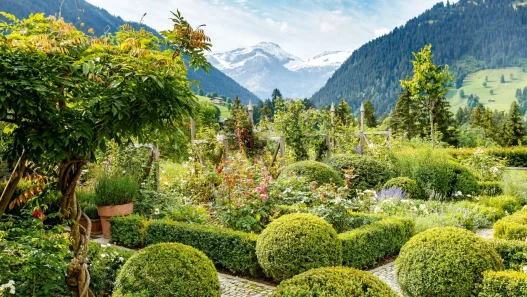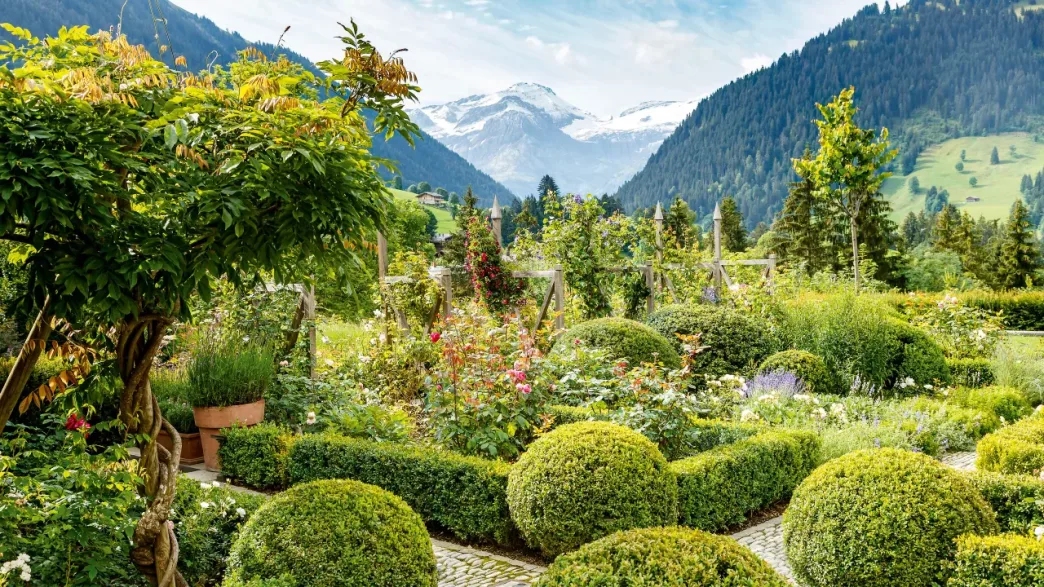Imagine a world where nature and human design intertwine, creating spaces that are both beautiful and functional. This is the domain of garden architecture, a discipline that blends landscape art with architectural principles. It is not just about planting flowers and trees; it is about creating a harmonious experience that connects us to the natural world.

Defining Garden Architecture: Concepts and Characteristics
Garden architecture is the art and science of designing outdoor space, taking into account the interaction of plants, structures and the environment. It is about creating a sense of place, a sanctuary where we can relax, reflect and connect with nature.
The key concepts in garden architecture are:
- Functionality: Gardens should be practical, serving a purpose beyond aesthetics. This could be providing space for recreation, growing food or simply offering a quiet retreat.
- Aesthetics: Beauty is very important in garden design. The arrangement of plants, the use of materials and the overall composition contribute to the visual appeal of the space.
- Sustainability: Modern garden architecture emphasises environmentally friendly practices such as the use of native plants, water conservation and waste minimisation.
Historical Context of Garden Design: Evolution through the Ages
Garden architecture has a rich history that has developed alongside human civilisation. From the ancient Hanging Gardens of Babylon to the formal French gardens of Versailles, every era has left its mark on garden design.
Early gardens were often utilitarian, serving as a source of food and medicine. Over time, gardens became more elaborate, reflecting the power and wealth of their owners. The Renaissance period saw an increased interest in classical design, while the Romantic period emphasised naturalism and emotion.
Understanding the Role of Nature: The Interaction between Architecture and Landscape
Garden architecture is about finding the perfect balance between the built and natural world. It is about understanding the characteristics of the site, the climate and the local flora and fauna.
Architects use their knowledge of materials, form and space to create structures that complement the surrounding landscape. This may involve incorporating existing trees into the design, using natural materials such as stone and wood, or creating paths that meander through the garden.
Cultural Importance of Gardens: Reflecting Social Values and Aesthetics
Gardens are more than just spaces for plants; they are reflections of our culture and values. Different cultures have developed unique garden traditions, each with its own symbolism and aesthetics.
For example, Japanese gardens emphasise simplicity and tranquillity, while Islamic gardens are known for their intricate geometric patterns. Gardens can also be used to express political or social messages, as seen in the gardens of the Soviet Union or the gardens of the American Civil Rights Movement.
Global Trends in Garden Architecture Practices
Today, garden architecture is a global phenomenon and new trends are emerging every day. Sustainable design is a key focus, with architects incorporating green roofs, rainwater harvesting systems and native plant species.
Interest in edible gardens, urban agriculture and community gardens is growing as people seek to reconnect with nature and create sustainable food systems.
As we move forward, garden architecture will continue to evolve in response to society’s changing needs and desires. It will be a space that embraces innovation, sustainability and the enduring beauty of the natural world.
Design Principles in Garden Architecture
Garden architecture is not just about planting beautiful flowers; it is about creating a functional space in harmony with the natural world. This is achieved through a set of design principles that guide the architect’s decisions and ensure a beautiful and purposeful result.
Spatial Organisation: Creating Harmony between Built Structures and Natural Elements
Imagine a garden where every element feels like it belongs, from winding paths to tall trees. This is the essence of spatial organisation in garden architecture. It is about creating a sense of flow and balance, where built structures and natural elements complement each other.
Architects consider factors such as
- Scale: the size and proportion of structures in relation to the surrounding landscape. A small pavilion can be overwhelming in a large meadow, while a large fountain can be lost in a small courtyard.
- Form: The shape and outline of structures and plant arrangements. Curved paths invite exploration, while straight lines create a sense of order.
- Rhythm: The repetition of elements such as rows of trees or a series of stepping stones creates a visual rhythm that guides the eye throughout the garden.
Plant Selection: Vegetation Selection that Enhances Design Intent and Local Ecology
Plants are the lifeblood of every garden and their choice is crucial to the overall design. Architects consider factors such as the following:
- Colour: The use of colour can create mood and atmosphere. Bright flowers add vibrancy, while cool tones can evoke tranquillity.
- Texture: Different plants have unique textures, from the smooth leaves of a hosta to the prickly needles of a pine. Combining textures adds visual interest and depth.
- Form: The shape and silhouette of plants can be used to create focal points, define spaces or provide screening.
- Ecology: Selecting native plants that thrive in local climate and soil conditions promotes biodiversity and reduces the need for excessive irrigation and maintenance.
Water Features: The Role of Aquatic Elements in Garden Design
Water is a powerful element in garden design, adding a sense of tranquillity, movement and life. Water features can range from simple ponds to elaborate fountains, each with its own unique character.
- Reflecting Pools: These tranquil bodies of water reflect the sky and surrounding landscape, creating a sense of depth and serenity.
- Fountains: Fountains add movement and sound to a garden, creating a lively and engaging atmosphere.
- Waterfalls: Waterfalls create a sense of drama and energy, drawing the eye and inviting contemplation.
Pathways and Circulation: Design for Movement and Exploration
Pathways are the arteries of a garden, guiding visitors through the space and revealing different landscapes and experiences. Architects take the following into account:
- Materials: Paths can be made of a variety of materials such as stone, gravel, wood and even grass. The choice of material should complement the overall design and the surrounding landscape.
- Width: The width of the pathway should be appropriate to the scale of the garden and the expected pedestrian traffic.
- Curvature: Curved paths create a sense of mystery and encourage exploration, while straight paths offer order and a sense of direction.
Notable Gardens and Architectural Innovations
Throughout history, countless gardens have pushed the boundaries of design and innovation. Here are a few examples:
- The Hanging Gardens of Babylon: This marvel of the ancient world featured terraces filled with exotic plants and showcased the creativity of early garden architects.
- The Gardens of Versailles: With their symmetrical layout and elaborate fountains, these formal French gardens epitomise the splendour of Baroque design.
- Japanese Zen Garden: With their carefully raked gravel and symbolic rocks, these minimalist gardens offer an experience of deep peace and contemplation.
These examples illustrate how garden architecture has evolved over time in a variety of ways, reflecting the changing values and aesthetics of different cultures.
As we move forward, garden architecture will continue to evolve, embracing new technologies, sustainable practices and a deeper understanding of the connection between humans and nature.
Materials and Construction Techniques in Garden Architecture
Just as a house is built with bricks and mortar, a garden is prepared with a variety of materials and techniques. Garden architecture is about understanding the properties of these materials and how they can be used to create beautiful, functional and sustainable spaces.
Natural Materials: Using Stone, Wood and Soil in Garden Design
Nature itself provides a wealth of materials for garden architecture. These materials not only blend seamlessly into the surrounding landscape, but also offer a sense of timelessness and durability.
- Stone: From hard rock to smooth paving stones, stone is a versatile material for pathways, walls and water features. It is durable, weather resistant and adds a rustic charm.
- Wood: Wood is warm, inviting and readily available. It is used for decks, fences, gazebos and even furniture and adds a natural touch to the garden.
- Soil: As the foundation of every garden, soil is essential for the growth of plants. When architects design gardens, they consider soil type, drainage and fertility to provide a healthy environment for plants to thrive.
Hardscaping: Integration of Non-Plant Elements into Garden Areas
Hard landscaping refers to the non-plant elements in a garden, such as paths, patios, walls and water features. These elements provide structure, define spaces and create a sense of order within the garden.
- Paths: Paths guide visitors through the garden, offering different views and experiences. They can be made of stone, gravel, wood or even grass, depending on the desired aesthetics and functionality.
- Verandas: Verandas provide a space for relaxing, dining or entertaining. They can be made of stone, brick, concrete or wood and can be designed to complement the surrounding landscape.
- Walls: Walls can be used to define spaces, provide privacy or create a sense of enclosure. They can be made of stone, brick, wood or even living plants.
- Water Features: Water features add movement, sound and a sense of tranquility to a garden. They can be as simple as a small pond or as elaborate as a cascading waterfall.
Environmental Considerations: Sustainable Practices in Material Selection
Modern garden architecture emphasises sustainability by minimising the environmental impact of the design and construction process. This includes the selection of the following materials:
- Locally Sourced: Using materials sourced from nearby areas reduces transport costs and emissions.
- Recycled or Reused:Using recycled materials such as reclaimed wood or salvaged stone reduces waste and promotes resource conservation.
- Durable and Long Lasting: Choosing materials that are weather and rot resistant minimises the need for replacement and reduces waste over time.
Lighting Design: Enhancing Garden Areas with Strategic Lighting
Lighting plays a crucial role in creating atmosphere and extending the enjoyment of a garden beyond daylight hours. Strategic lighting can emphasise key features, create a sense of mystery and enhance the overall ambience.
- Ambient Lighting: Ambient lighting creates a soft and inviting atmosphere by providing general illumination. It can be achieved using string lights, lanterns or low-voltage path lights.
- Accent Lighting: Accent lighting is used to emphasise certain features such as statues, trees or water features. It can be achieved using spotlights, uplights or wall sconces.
- Task Lighting: Task lighting provides focussed lighting for specific activities such as reading or eating. It can be achieved using table lamps, pendant lamps or wall sconces.
By carefully selecting materials and using sustainable construction techniques, garden architects can create spaces that are not only beautiful but also environmentally sensitive.
The Role of Gardens in Enhancing the Human Experience
Beyond their aesthetic appeal, gardens have a profound power to enrich our lives. They offer a refuge from the hustle and bustle of modern life, providing a space for relaxation, reflection and connection with the natural world.
Therapeutic Benefits: The Psychological Impact of Garden Areas
Research has shown that spending time in nature has a positive effect on our mental and physical health. Gardens in particular offer a range of therapeutic benefits:
- Stress Reduction: The sights, sounds and smells of a garden can have a calming effect on the nervous system, reducing stress and anxiety.
- Improved Mood: Exposure to sunlight and fresh air can increase serotonin levels, leading to feelings of happiness and well-being.
- Enhanced Creativity: The beauty and tranquillity of a garden can inspire creativity and foster a sense of wonder.
- Increased Focus: Spending time in nature can increase concentration and attention span, making it a valuable tool for those seeking mental clarity.
Community Participation: Designing Gardens as Social Spaces
Gardens can be powerful tools for encouraging community participation and building social connections. They provide a common space for people to come together, interact and learn from each other.
- Community Gardens: Community gardens provide a space for residents to grow food, share information and build relationships.
- Public Parks: Parks provide a place where people can relax, play and socialise. They can be designed to host a variety of events, from picnics to concerts and sports.
- School Gardens: School gardens provide students with a hands-on learning experience by teaching them about plant science, sustainability and the importance of nature.
Educational Opportunities: Gardens as Living Laboratories for Learning
Gardens are living laboratories that offer rich educational opportunities for people of all ages. They can be used to teach the following:
- Botany: The study of plants, including classification, growth and reproduction.
- Ecology: The study of the relationships between organisms and their environment.
- Sustainability: The importance of conserving resources and protecting the environment.
- Horticulture: The art and science of growing plants.
Seasonal Changes: Designing for Year-Round Interest and Engagement
A well-designed garden offers something to enjoy all year round. By combining plants that bloom at different times, architects can create a constantly evolving and interesting space.
- Spring: The garden comes to life with vibrant flowers, attracts pollinators and gives a feeling of renewal.
- Summer: The garden is in full bloom, providing shade and a cool refuge from the heat.
- Autumn: the leaves change colour, creating a breathtaking display of reds, oranges and yellows.
- Winter: The garden may look dormant, but there is still beauty to be found in bare branches and winter hardy plants.
By embracing the changing seasons, garden architects can create spaces that are not only beautiful, but also provide a sense of wonder and connection to the natural world.
Challenges in Garden Architecture
Creating a beautiful and functional garden is a rewarding endeavour, but not without its challenges. Garden architects must navigate a complex interplay of environmental, practical and social considerations to achieve a successful outcome.
Environmental Sustainability: Addressing Climate and Ecological Concerns
The impact of climate change and the need for ecological protection are important concerns for modern garden architecture. Architects should consider the following:
- Water Conservation: Designing gardens that use water efficiently, incorporating drought-tolerant plants, rainwater harvesting systems and efficient irrigation methods.
- Native Plant Selection: Selecting plants adapted to local climate and soil conditions, promoting biodiversity and reducing the need for fertilisers and pesticides.
- Climate Resilience: Designing gardens that can withstand extreme weather events such as droughts, floods and heat waves by combining resilient plant species and sustainable infrastructure.
Maintenance Considerations: Design for Longevity and Maintenance
A well-designed garden should be both beautiful and easy to maintain. Architects should consider the following:
- Plant Selection: Select plants that are appropriate for site conditions and require minimal maintenance, such as low-water plants or disease-resistant species.
- Paths and Circulation: Create paths that are accessible and easy to navigate, minimising the need for mowing or weeding.
- Hardscape: Use durable materials for hardscape elements such as stone or brick that require minimal maintenance.
Site Constraints: Navigating Topography and Soil Conditions
Each site presents its own unique challenges, from steep slopes to poor soil conditions. Architects should be able to
- Design gardens in harmony with the existing terrain, incorporating terraces, retaining walls and other features to create a harmonious and functional space.
- Addressing Soil Issues: Using soil amendments, drainage systems and other techniques to improve soil quality to ensure plant health and growth.
- Maximising Space: Creating a sense of spaciousness and flow in small or challenging spaces through smart design strategies.
Community Engagement: Involving Stakeholders in the Design Process
Garden architecture is often a collaborative process involving input from clients, community members and other stakeholders. Architects should be able to
- Communicate Effectively: Explain design concepts clearly and listen to feedback from all interested parties.
- Consensus Building: Facilitate a collaborative process that leads to a design that meets the needs and desires of everyone involved.
- Considering Cultural Context: Designing gardens that are sensitive to the cultural values and traditions of the community.
By addressing these challenges head-on, garden architects can create spaces that are not only beautiful and functional, but also sustainable, resilient and responsive to the needs of the community.





















